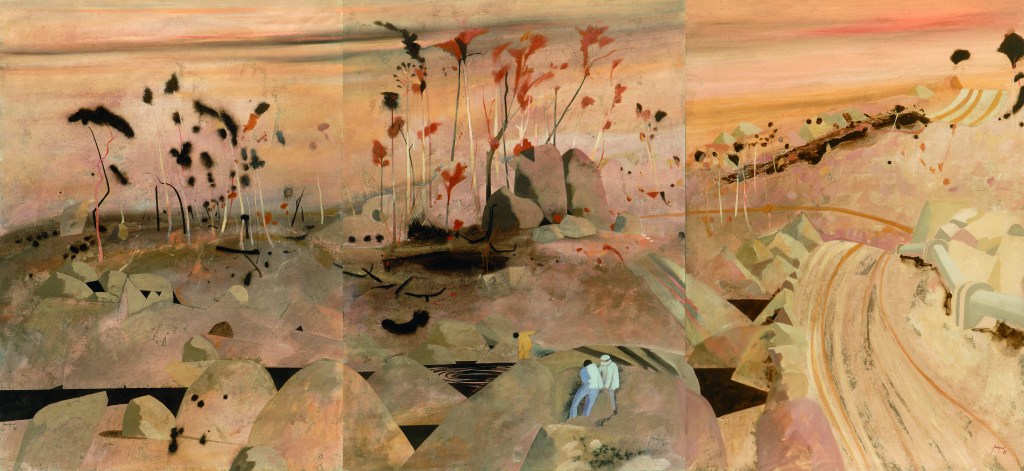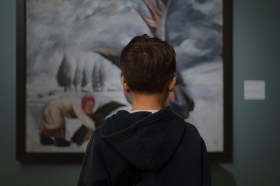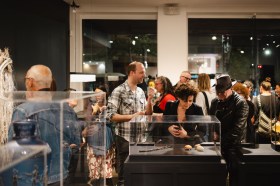Rhythms of the Earth and Where Lakes Once Had Water are two very different exhibitions, joined by theme if not by style. Together they present a multi-faceted exploration of the rhythms of the Australian landscape, the impact we are having on it, and the deep ancient past that is still present.
Rhythms of the Earth is a rare opportunity to see an impressive collection of landscape artists, drawn from TarraWarra Museum of Art’s permanent collection. Presenting modernist, contemporary and First Nations perspectives on the Australian landscape, it’s worth heading into this beautiful gallery just to see all these artworks together. The exhibition is a vivid reminder of the diversity of our landscape and the artists who paint and draw it.
Featuring Arthur Boyd, Clifford Possum Tjapaltjarri, Godfrey Miller, Jeffrey Smart, Emily Kame Kngwarreye, John Mawurndjul, Clifton Pugh, Fred Williams, Russel Drysdale, Rover Thomas, Mandy Martin, Robert Juniper, Philip Wolfhagen, and more, the show takes you from one exquisite and extreme Australian landscape to the next, via a wide range of aesthetics and eras. Each artist is a leader in landscape art, and the exhibition is a celebration of Australia’s artists and our land.
Six pieces by Judy Watson from 2016 are swirling earthen landscapes, using the topography of nearby hills such as Mount Donna Buang and Mount Baw Baw to present an eagle’s eye view of the ranges. Using browns, reds and oranges, these engrossing images evoke the colours of Australia and showcase the steep and dramatic escarpments of our hills.
Purling Brook Escarpment (2005) by William Robinson is a layered, exquisite piece. Delicately detailed ferns, messy dark trees and entangled leaves all seem to lean out of the canvas towards the viewer, as if we’re a bird perched on high, looking at the rainforest through a fisheye lens.
Angelina Pwerle’s Bush Plum (2008) triptych is captivating. The three long canvases are filled with her characteristic layered dot painting, complete with lush purples and reds that create a swirling image from thousands of tiny dots. The pieces are complex and intricate, representing the landscape around Alice Springs and Pwerle’s bush plum dreaming.
Brett Whiteley’s Australia (1970 – 1974) is a grandiose homage to the iconography and Australiana of a past that is still recognisable. The curved sweeping Whiteley lines are juxtaposed with tiny, elongated creatures that seem to cling to the surface of a curved red desert. A real tree branch and stuffed cockatoo protrude from the canvas. As a landscape, it’s evocative and bold, a nod to bygone eras and the environmental impact of cities and industries.
Two pieces by John Olsen explode from the walls. Emus Passing (1969) is a layered, staccato canvas of yellows, browns and blacks. Emu shapes are embedded in tangled darkened bush offset by soft yellow light. Country Life Rydal (1998) draws you into its black and yellow heart. Black tendrils crawl across the canvas, covering the blue and yellow landscape. It’s beautiful and violent in its use of colour and shape.
Where Lakes Once Had Water meanwhile, is a multi-media exploration of deep time in Australia by Sonia Leber and David Chesworth. The exhibition blends science, art, video, voiceovers and soundscapes to present an engrossing and new way of looking at, hearing and experiencing Australian landscapes. Where Lakes Once Had Water is a sensory experience, a reminder of how ancient our land is, and an homage to the wild nature of Australia.
At the heart of this exhibition is a 28-minute video presented across two screens, accompanied by an audio soundscape that at times jars and interrupts the visuals and at times adds emotional layers to the experience. Sonia Leber and David Chesworth took video and sounds during scientific explorations of earth and water in the Northern Territory on Larrakia Country in 2018 and 2019. The outcome is an engrossing video that shows deep cores being drawn from the earth at Lake Woods and from a body of water, Girraween Lagoon. Layers of dark and pale soil show different eras in the land’s history and different environmental impacts of flood, dry, inland water and fire.
The video provides a unique opportunity for everyday people – those who are not geologists, scientists or environmentalists – to see hundreds of thousands of years into the past. We see the arid land give up secrets. We see radiocarbon dating and fossils and flecks of pollen. We see scientific graphs that highlight the plant species identified in earthen cores that reaches back thousands of years. We hear the scratching, scrabbling sounds of ants in the earth. We hear the liquid sounds of water surrounding us.
The soundtrack takes its cues from the sounds the scientists make as they dig into the earth, drill into a lake, sift through dry red dirt. But added to the soundscape is a strange voiceover, at times pre-empting the visuals, at times over-explaining them. Although the voice occasionally felt imposing, its scratchy tones echo the dry dusty land the scientists are working with.

Accompanied by a booklet with text by well-known palaeontologist and science communicator Tim Flannery, the exhibition reminds us that we are but moments on the surface of this vast changing land. The video and book reveal the extremes of Australia, the depths, the history, and today’s inhabitants: red-tailed black cockatoos, termites, scientists and First Nations people. The start of the film shows Marlinja man Ray Dimakarri Dixon walking among the trees, his feet careful on the earth, asking the spirits of the land to stay and look after Country while the scientists are there working. It’s an important part of the video, but it’s also a reminder that there are many stories of the land.
Read: Exhibition Review: HOME|LAND
There is much more to Where Lakes Once Had Water and indeed to Rhythms of the Earth. The beauty and harshness of the Australian landscape, the depth of its past, the vibrance of its colours, and the impact humans (especially Europeans) have had are all explored and expressed in these two exhibitions. This show will reward beyond the visiting, as the pieces and the experiences will stay with you.
Rhythms of the Earth: Selected Works from the TarraWarra Museum of Art Collection and Sonia Leber and David Chesworth: Where Lakes Once Had Water will be displayed at TarraWarra Museum of Art, Victoria until 13 November 2022.





